|
Foreword:
Many people find this page because they're looking for ways to make their computer a bit faster without replacing it. Later on this page, the internal components will be covered. First, we'll cover the various items that can cause a computer to perform poorly.
Making Your Computer Faster
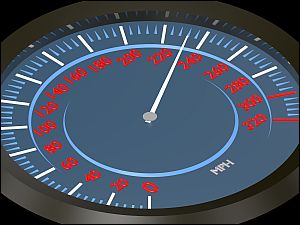 Many (most) people think that having a lot of files on their hard drive slows the computer down and many want to delete all possible files (even small text files). In fact, unless your hard drive is very nearly 100% full, those files will make very little difference in performance. Most people have far more available space than they need. Unless you have a really small drive (more likely if it's an old computer/drive) AND you have a lot of video files stored, there is very little chance that the hard drive is full. For most computer users, 10 gigabytes of free space is more than enough.
Many (most) people think that having a lot of files on their hard drive slows the computer down and many want to delete all possible files (even small text files). In fact, unless your hard drive is very nearly 100% full, those files will make very little difference in performance. Most people have far more available space than they need. Unless you have a really small drive (more likely if it's an old computer/drive) AND you have a lot of video files stored, there is very little chance that the hard drive is full. For most computer users, 10 gigabytes of free space is more than enough.
There are several things to consider when you want to upgrade your computer to make it a bit faster without replacing it. Some of what follows will only be possible with relatively new computers (less than 4 years old). Computers more than 4 years old likely need to be replaced because the overall architecture of the system is not capable of handling all of the newer types of files (video, etc.) efficiently.
All of the following assumes that you have no infections on your computer. Infections can cause a slowdown (and are generally the reason a computer has become slower). You should do a full scan with several anti-virus and anti-malware programs if you think your computer may be infected. Page 8 (in the directory) of this site has many of the tools you'll need to get your computer clean and working as efficiently as possible.
Slow Internet Connection:
If your main complaint is that web pages take too long to load (in general, not on just one or two sites, which may have slow servers), you may need to upgrade your internet service. In the early days of the internet, a dial-up internet connection was the only option for most people. In general, a dial-up connection is extremely slow. It's usable for someone who only uses their computer once or twice a day for email but they're impractical for most computer users. DSL was a good alternative for a while but it's being phased out as most of the internet service providers go to either cable or fiber optic lines. An internet connection from your cable TV provider is probably the minimum that most people will find acceptable. It's relatively fast and pages for most sites will load within a few seconds. If your internet service provider offers a fiber-optic connection, that will likely be the fastest connection possible. There are various 'packages' that you can buy that determine the maximum download speed. The fastest connection will be the most expensive. You have to decide what it's worth to you when selecting the internet service you buy.
CPU/Processor Upgrade:
If your internet connection is fast enough but you still have to wait on your computer to perform various tasks, open the Task Manager (right-click on the Task Bar) and select the performance tab in the Task Manager. Set the option for the Task Manager to always remain on top (OPTIONS >> ALWAYS ON TOP). Perform a few of the most common tasks that are slow. If the CPU Usage goes to 100% and remains there for an extended period of time (more than a few seconds), your processor may be the bottleneck in your system. This can often be seen when you go to a site and watch video. Higher quality video (which many of the news sites are using now) are especially hard for an older processor to handle. If the video is choppy and your processor usage remains at 100% the entire time that the video is playing, you need a faster processor.
You can determine what processor you have by right-clicking COMPUTER (either on the desktop or in the start menu) and selecting PROPERTIES. THIS is the system properties from a new computer (mid 2011). It has a relatively slow processor (actually, the slowest available at this time) but it handles all but the most demanding video smoothly. It can even handle most 1080P HD video. As you could see from the system properties, it's only a 2.8g processor but since it a newer processor (newer architecture and newer instruction sets), it can actually perform much faster than the 3GHz+ processors from a few years ago.
If your computer/motherboard is not more than a few years old, you may be able to upgrade the processor. If you have a mass-produced computer (Dell, HP...) you can go to the manufacturer's web site or call them to see if a better/faster processor is available. If you have a computer that you built or was built by a local computer shop, you can find the motherboard you have by using PC Wizard 2010 (or whatever the latest version is, it's on the CPUID web site, don't DL counterfeits from other sites). Find the supported CPU list for that motherboard. THIS is an example of a CPU support list for the motherboard used in the computer above. If your processor is on the low-end of the CPUs that can be used with that motherboard, buying a faster processor (higher clock speed and/or more cores, if available) will help speed up your computer. Bear in mind that going from a 2.8GHz to a 3.0GHz processor (same number of cores) won't make much of a difference but going from a 2.8GHz single core to a significantly faster processor (3.4GHz) or going to a quad core processor may make a significant difference. It's also possible that 'upgrading' from a 3.2GHz single core to a 2.8GHz quad core could make the computer significantly faster. It may seem counterintuitive that a 2.8GHz could be faster than a 3.2GHz but having multiple cores can make a huge difference in speed.
Too Little Memory:
If the CPU usage is low when you have to wait on your computer to perform certain, common tasks (opening programs...). the problem may be the hard drive or the memory. If you don't have enough memory, the computer has to shuffle files from RAM to temporary files on the hard drive to have the most important ones in RAM (Random Access Memory). This can slow a computer down significantly. For Windows XP and the 32 bit version of Windows 7, 1g (1g = 1 gigabyte) is enough for most users. For the 64 bit version of Windows 7, I'd recommend 2g as the minimum. Memory is relatively inexpensive and if a lack of memory is causing your system to slow down, it's a good investment. When buying memory, you need to consult the manufacturer's site. If the computer wan not built by one of the large computer companies, download owner's manual for the mother board to see what type of memory it uses and the maximum amount of memory that's supported. You also need to find the maximum supported by the operating system. XP (the 32 bit version) is limited to about 3.2GB. If you install 4GB, you'll only see a bit over 3GB available. The various versions of Windows 7 support different amounts of memory. The basic versions only support 2GB. The ultimate version can support up to 192GB. THIS page shows the memory supported by the various versions of Win7.
Slow Hard Drive:
If the hard drive is the bottleneck, you need to determine what hard drive you have. After determining what hard drive you have with PC Wizard, look up the specs for the hard drive (Google). If it's a 5400RPM drive or a 'green' drive (often 5400RPMs), you could possibly speed up your system with a standard 7200RPM drive. Many people are going to 'solid state' drives. SSD drives are MUCH faster than standard drives but are relatively expensive when you look at the cost per gigabyte of storage. The SSD drives are mainly used as the boot drive for now and standard (spinning disk) hard drives are used to store files where more storage capacity is needed. The system mentioned above (slowest processor available) with an SSD drive was faster (for most tasks) than many of the computers with much faster processors (higher clock speeds as well as more cores) that were running standard drives (even those running high performance 10,000RPM drives).
Internal Components of a Basic Computer
If you didn't fully understand the terms used above, the following information should be interesting. Although this is a fairly basic computer, it has all of the necessary components needed for basic operation (many integrated into the motherboard) but it isn't anything special. Other computers will have many more components inside of them. The following image shows the side of the computer with the left side cover removed. As you can see, it's mostly empty space. The large circuit board with all of the electronic components on it is the motherboard. If you look at the top left (black box with the specs printed on it), that's the power supply. All of those yellow, red, black and orange wires (covered with braided sleeving) originate in the power supply. It converts the household mains voltage (120 volts AC in the US) to ±12v, ±5v, and +3.3v (all DC voltages). Virtually all power supplies have fans. This is many times the source of the noise you hear when the computer is on. I will go into more detail on variations in power supplies on a page later in the tutorial.
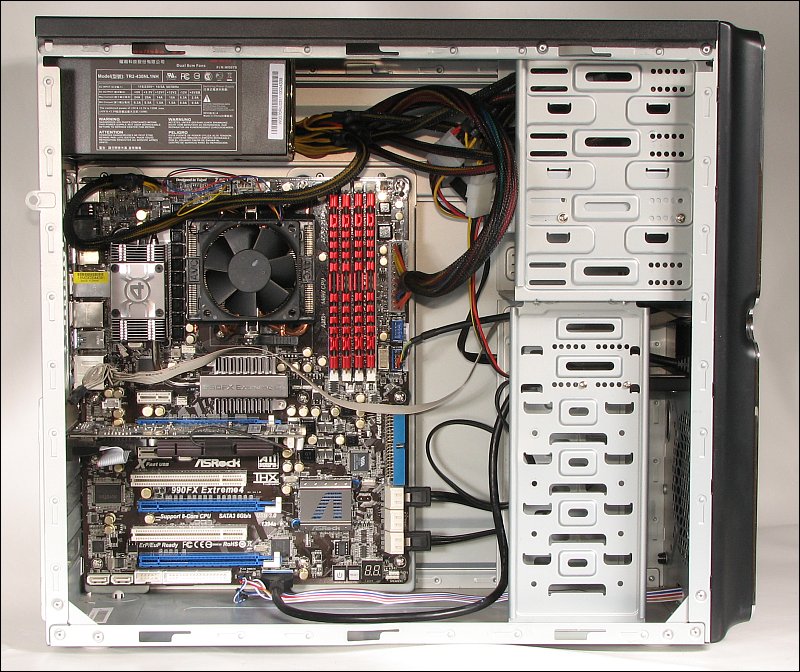
Expansion Slots:
As I said before, many components are integrated into this motherboard. Two of the most important are the sound and LAN (internet/ethernet) driver ICs. On most motherboards, these are standard. At one time, the integrated ethernet and sound ICs were inferior and it was common to upgrade them. For the most part, the integrated sound and ethernet are good enough for all but the most demanding users. Many motherboards include an integrated video graphics adapter but that's not the case on this board. A dedicated graphics card is in the top expansion slot. When the board has an integrated graphics adapter, it's also good enough for most users. The exceptions are those who are interested in computer gaming. Gaming requires a more powerful processor than ordinary tasks. There are a few motherboards that have on-board video with more advanced graphics processors. They are the AMD APU motherboards that are to be used with the APU processors. These are suitable for light to moderately sophisticated 3D gaming. This motherboard has PCI-E x1 (short white) and x16 (long blue) slots. The medium length white slots are PCI slots. These will be covered in more detail on other pages of the site.
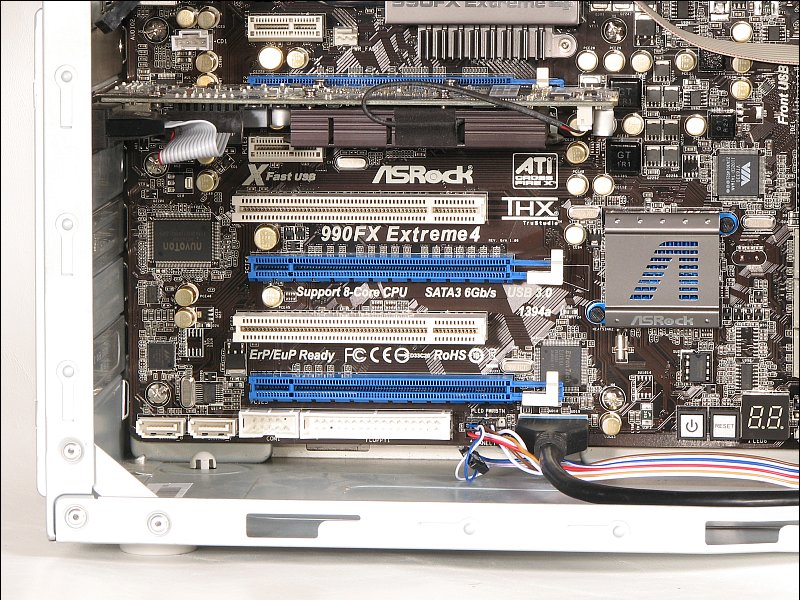
The Hard Drive:
I've heard many people call the computer (the entire case that holds all of the components), the 'hard drive'. In reality, the hard drive is just this little device that you see below. We showed you the insides of an older hard drive earlier in the tutorial. This is a 64GB (sixty-four gigabyte) 'solid state' hard drive. While a 64GB hard drive is relatively small, it's good enough for most users. I've used 64GB drives in many of the computers I've built and there was never a time when it was too small for all of the programs that I and those for whom they were built. Most are only about half full after all software has been loaded. For those who have large files (lots of music, video, games...), a standard hard drive is used for storage. Many people expect to see a physically larger drive when they buy a drive with more capacity. For any of the various types of drives (solid state or conventional, with spinning platters) the physical size is essentially the same for all available capacities. If you look at the back of the drive you can see the two cables. The cable with the wider connector is a power supply cable. The cable with the narrower connector is the data cable. This is a SATA drive. If it were an IDE drive, it would have a wide, 40 conductor connector.
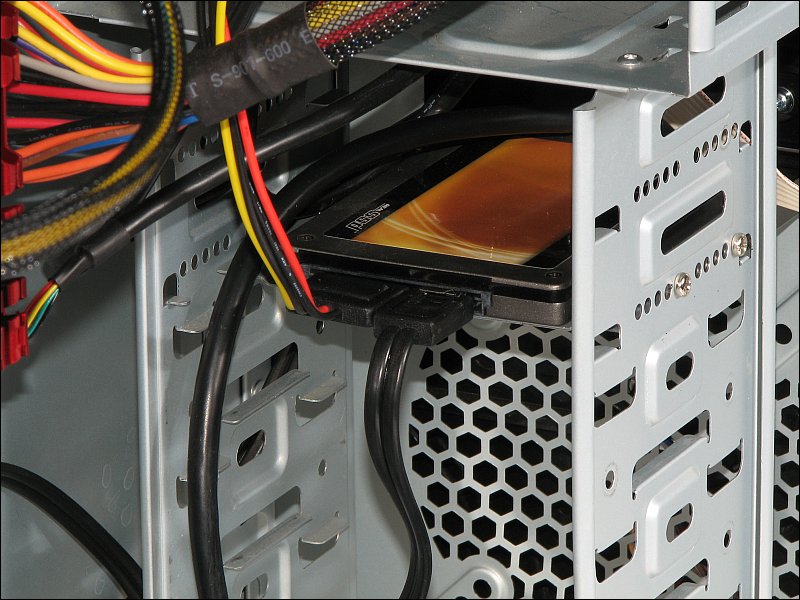
Memory:
Below, you can see that the computer has 4 memory slots and 4 sticks of memory (memory modules). Not all slots need to be filled and many computers only have one stick of memory installed. Without reading the numbers from the side of the memory sticks, you can't tell what their capacity or rating is. The total memory below could be 2GB (gigabytes) or 32GB. These are actually 4GB each for a total of 16GB. This is a bit of overkill. For most users, 2GB is plenty and more (for most common tasks) will do very little to improve the performance of your computer.
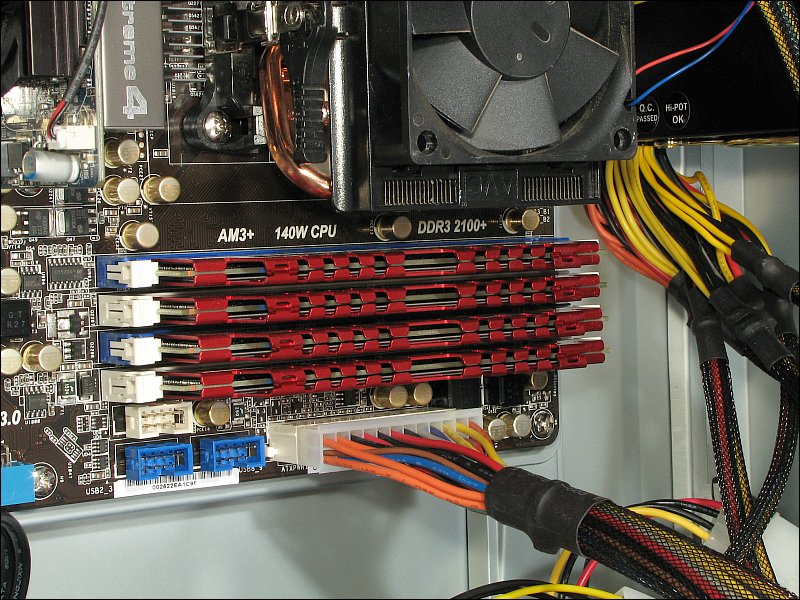
PWM Regulator:
As was mentioned earlier, the computer's power supply produces the voltages needed by the computer. Well, there is another voltage conversion needed. It's for the CPU. The CPU runs on very low voltage. This particular one runs on 0.9-1.4 volts (approximately). The lower voltage allows more efficiency at the high operating frequency used in the CPU (less energy turned to heat). To get from the 3.3 volt to the voltage that the CPU needs, the computer uses a switching voltage regulator. In the following picture, you can see the switching regulator components. The green arrows point to; A: transistors, B: capacitors, C: inductors.
The CPU:
For most tasks, the CPU is the component that does all of the work. The CPU is typically mounted in a socket on the motherboard but it's not visible due to the heatsink and fan that are mounted on top of it. You can see one example of a CPU in the following image.
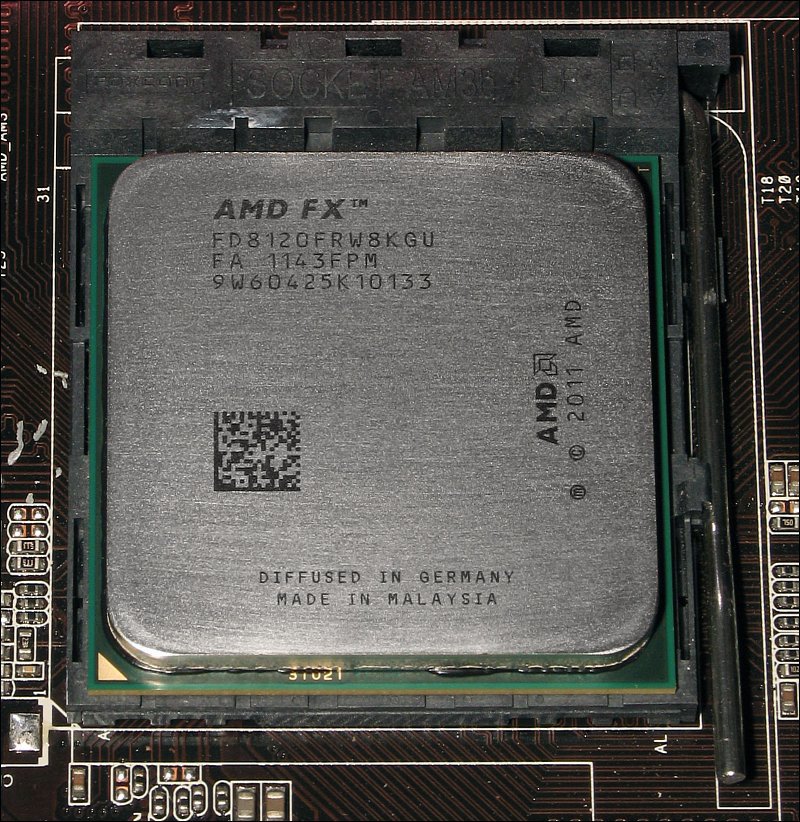
Heatsink and Fan:
In the following images, you can see two different styles of heatsink and fan (HSF for short). As you can see it's simply a fan mounted to the heatsink. The heatsink is then mounted so that it makes contact with the top of the CPU. The heatsink soaks up heat from the CPU. If there were no heatsink, the processor would fail (if there were no thermal protection built in - thermal protection is getting more common). The one on the left is a 'stock' heatsink and fan. It's what's supplied with the CPU by the manufacturer and is good enough for most users. Most CPUs are idle for the great majority of the time that they're in operation so it's not difficult to keep them cool. When a CPU is pushed to the limits for an extended period of time (gaming, benchmarking, video encoding...), sometimes more cooling is required. The HSF on the right is an aftermarket cooler (Cooler Master Hyper 212 EVO) and can remove considerably more heat than the OEM HSF. The additional cooling will keep the CPU cooler when it's driven hard which can prevent it from failing prematurely. Again, this is not needed for most users. Most computer tasks produce only intermittent heavy loading for the CPU.
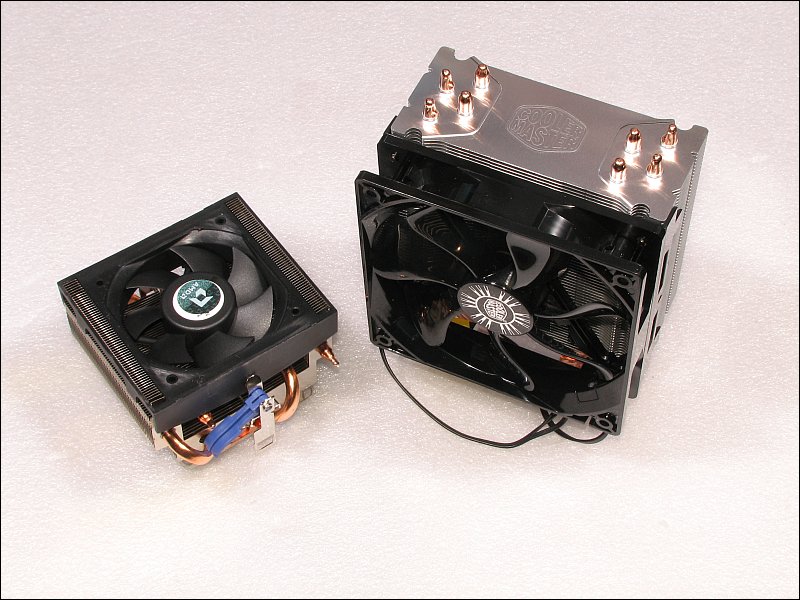
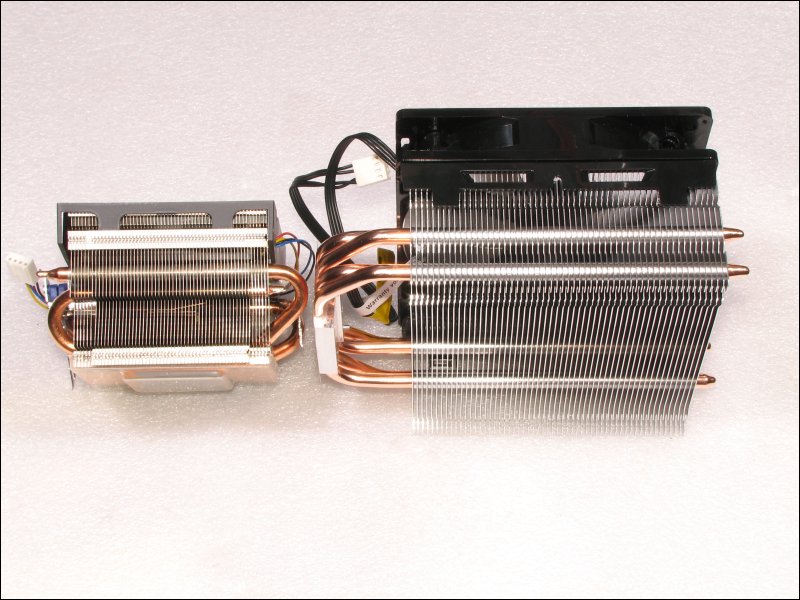
Power Supply:
The following images are of a generic power supply. This is the type of power supply that you will get when you buy an inexpensive computer case and the power supply is included. It is rated to produce 350 watts. If you look at the label, you can see the various maximum current ratings for the various output voltages. This is a low-end (budget) supply. Power supplies used for high-end computers (powerful CPUs, one or more powerful video cards...) will have supplies rated as high as 1500 watts. Power supplies for simple basic computers (particularly those in very small computer cases) may be rated below 200 watts. A minimal computer similar to what I'm using in the tutorial won't need anything larger than a 250 watt supply but it's always good to have more power than you need. A supply rated to produce significantly more power than you need will run cooler and live longer than one that's continually being pushed to its limits.
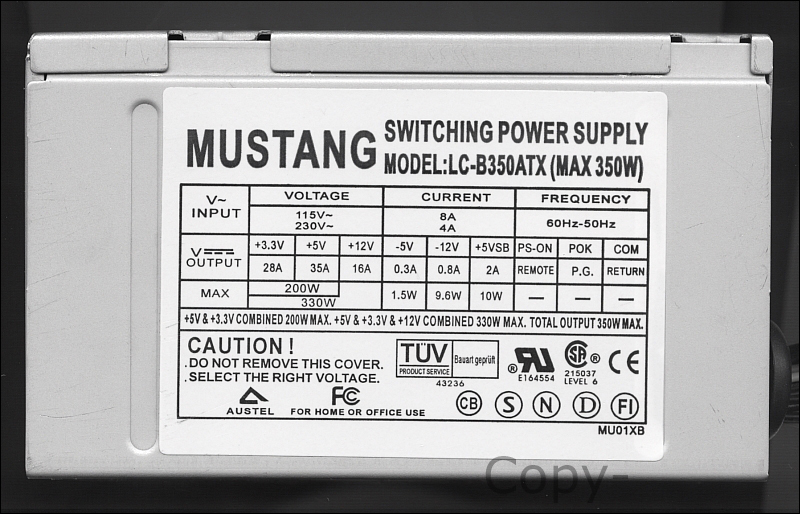
|
You May Be Interested in My Other Sites
-
This site was started for pages/information that didn't fit well on my other sites. It includes topics from backing up computer files to small engine repair to 3D graphics software to basic information on diabetes.
-
This site introduces you to macro photography. Macro photography is nothing more than the photography of small objects. It can take quite a while to understand the limitations associated with this type of photography. Without help, people will struggle to get good images. Understanding what's possible and what's not possible makes the task much easier. If you need to photograph relatively small objects (6" in height/width down to a few thousandths of an inch), this site will help.
-
If you're interested in air rifles, this site will introduce you to the types of rifles available and many of the things you'll need to know to shoot accurately. It also touches on field target competition. There are links to some of the better sites and forums as well as a collection of interactive demos.
-
This site is for those who want to install or update their car stereo. It begins with the most basic electronics theory, progresses into basic transistor theory as well as covering virtually everything associated with car audio.
|
|








 Many (most) people think that having a lot of files on their hard drive slows the computer down and many want to delete all possible files (even small text files). In fact, unless your hard drive is very nearly 100% full, those files will make very little difference in performance. Most people have far more available space than they need. Unless you have a really small drive (more likely if it's an old computer/drive) AND you have a lot of video files stored, there is very little chance that the hard drive is full. For most computer users, 10 gigabytes of free space is more than enough.
Many (most) people think that having a lot of files on their hard drive slows the computer down and many want to delete all possible files (even small text files). In fact, unless your hard drive is very nearly 100% full, those files will make very little difference in performance. Most people have far more available space than they need. Unless you have a really small drive (more likely if it's an old computer/drive) AND you have a lot of video files stored, there is very little chance that the hard drive is full. For most computer users, 10 gigabytes of free space is more than enough.